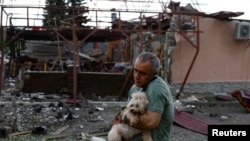The Pentagon says Ukraine can use U.S.-supplied weapons to counter any cross-border incursion from inside Russia, as long as it does not use long-range munitions to strike deep inside Russian territory.
“Ukraine’s ability to return fire on those ground forces, using munitions provided by the United States, is self-defense, so it makes sense that they would be able to do that,” Pentagon press secretary Maj. Gen. Pat Ryder.
When asked to specify whether that permission extended beyond the Kharkiv region, Ryder replied: “Correct.” He added that US policy calling on Ukraine not to use long-range missiles (known as ATACMS) provided by Washington to attack inside Russia has not changed.
President Joe Biden initially loosened restrictions over Ukraine’s use of US-supplied munitions to enable attacks inside Russian territory late last month. The change came in response to Russian ground forces launching cross-border attacks from Russian territory into the Kharkiv region of northern Ukraine. Before the change, Ukraine could not use weapons provided by the United States to counterattack at launch sites inside Russia.
Before Thursday, the Pentagon had repeatedly told reporters that the relaxed U.S. policy permits were specific to defending the Kharkiv region.
“Ukraine requested permission to conduct counterattacks in the Kharkiv area using American weapons, and President Biden granted them permission to do so,” Defense Secretary Lloyd Austin said in response to a question from the Voice of America last week about whether Ukraine could attack forces inside Russia that were launching attacks on Ukrainian forces outside Kharkiv.
“The ability to fight back in this hand-to-hand fight in the Kharkiv region, that’s what it’s all about, and my expectation is that the Ukrainians will put that to good use,” he added.
Pentagon deputy press secretary Sabrina Singh gave a similar response to reporters on June 5.
“The policy change you are referring to, which was announced last week, had more to do with the crossfire within the Kharkiv region,” he said.
“Self-defense is not an escalation”
During a surprise appearance at the Shangri-La Dialogue in Singapore earlier this month, Ukrainian President Volodymyr Zelenskyy thanked the United States for the policy change, which he described as allowing Ukraine to “use HIMARS in the Kharkiv region against border territory “. However, he stressed that the policy change was not enough.
“I have mentioned before as an example the airfields from which Russia bombs Ukraine, knowing that Ukraine will not bomb them in response,” he said.
NATO Secretary General Jens Stoltenberg said on June 7 that limiting Ukraine’s ability to attack “legitimate military targets” inside Russia was like asking Ukrainians “to try to defend themselves, defend the right to self-defense, with one hand tied behind his back.”
“Self-defense is not an escalation,” he stressed. “The border and the front line are more or less the same.”
Retired Gen. Frank McKenzie, former head of U.S. Central Command, told the VOA on June 10 that Ukraine should be able to attack military targets inside Russia “with certain limits” in areas such as Russian nuclear-capable sites, rather than specific geographic limitations.
National Security Advisor Jake Sullivan confirmed the apparent expansion of the policy for Ukrainian ground attacks inside Russia in an interview with PBS News on Monday, saying the permission extends wherever Russian forces are trying to invade.
“It extends to any place where Russian forces cross the border from the Russian side to the Ukrainian side to try to take additional Ukrainian territory,” Sullivan said, adding that “it’s not about geography. It’s about common sense.”
Michael Carpenter, senior director for Europe at the National Security Council, told the Ukrainian Service of the VOA on May 31 that the U.S. policy change applied to attacks against Russian “counterfire capabilities” deployed just across the border, but did not specifically limit Ukrainian targets to the Kharkiv region.
“This is intended for Ukrainians to defend themselves from what would otherwise be a Russian sanctuary,” he told the VOA.
Hostile aircraft
The United States has apparently not imposed any restrictions on attacks on military targets in Russian airspace.
Earlier this month, White House national security spokesman John Kirby told reporters that there was never a US restriction on Ukrainians shooting down hostile aircraft, “even if those aircraft are not necessarily in Ukrainian airspace.” “.
“They can shoot down Russian planes that represent an imminent threat, and have done so since the beginning of the war,” he concluded.
Connect with the Voice of America! Subscribe to our channels Youtube, WhatsApp and to the newsletter. Turn on notifications and follow us on Facebook, x and instagram.












Add Comment